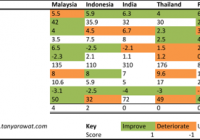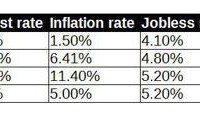India Emerges As An Attractive Option As Lower Chinese PMI And Steel Output Support The Bears
Summary Continued weakness in China makes India an attractive investment destination for investors looking to allocate funds to their emerging market portfolio. The benchmark Shanghai Composite index was absolutely crushed on Monday, falling 8.48%, or 345 points. The decline was the largest in percentage terms since February 2007. Besides, the recent number for the Chinese preliminary Purchasing Managers’ Index (PMI) in July surprised many on the downside, as it stood at 48.2 versus the Bloomberg consensus estimates (49.4). The World Steel Association posted a 1.3% decline in Chinese crude steel output for H1 FY15. The global economy is at a greater risk from the slowing China. As a counter move, investors may find the Indian stock market more attractive and a less volatile option. The recent number for the Chinese preliminary Purchasing Managers’ Index (PMI) surprised on the downside and stood at 48.2 vs. the Bloomberg consensus estimates of 49.4. The PMI from Caixin Media and Markit Economics indicates a contraction below the value of 50. Growth concerns spurred by the low PMI number also find support in a lower crude steel output. In its latest release on 22 July, the WorldSteel Association posted a 1.3% decline in Chinese crude steel output for H1 FY15. WorldSteel represents approximately 170 steel producers (including 9 of the world’s 10 largest steel companies), national and regional steel industry associations, and steel research institutes. China continues to see lower steel output due to a slump in the housing market, persisting credit crunch and weak infrastructure investments. This negatively impacts the steel demand in the region that accounts for 50% of global steel consumption. It is being argued by the market participants that the Chinese Steel Industry may have peaked in 2014 and now the days of record high steel consumption are over. This is also a result of the fact that China has been trying to move from an investment lead to a consumer driven economy. The recent stock crash may have greater negative implications than perceived by the market We argued in our recent post ” China’s moves to counter its stock market freefall riskier than perceived ” that the recent stock crash on July 8 and the ensuing reaction by the authorities may have greater negative implications than perceived by the market. The concerns are being shared by the government, corporates and investors alike. The Chinese stock markets had recovered about 15% from their early July debacle, before the Shanghai Composite Index experienced its biggest one-day drop since 2007. It lost a further 8.5% on July 27th. This is being attributed largely to the drastic steps the officials took from halting trading of more than 1,400 companies, to banning major shareholders from selling stakes, to restricting short selling and to suspending IPOs. The limited stock price recovery since 8 July followed by the biggest drop of the index in the last 8 years, the weak PMI and the steel data indicates the precarious situation that China finds itself in. The international investors have found India as an attractive option On the other hand, a direct beneficiary of the Chinese stock rout has been the Indian stock market . International investors are pulling out of China and have found India as an attractive option. The Shanghai-Hong Kong exchange saw record outflows amidst the $2.8 trillion plunge in the same mainland equity values since June 12th. According to Bloomberg, the international investors have ploughed $705 million in India over the same period, resulting in a world-beating 7% gain in the benchmark S&P BSE Sensex index . Slowing China, which was the driver of the previous commodity super-cycle, has also had a direct impact on commodity prices that are on a downward trend. Lower commodity prices have not only helped the Indian government in tackling the Balance of Payments situation, but also reduced the raw material cost for Indian organizations. The global economy is at a greater risk from the Orient than from the “new” sick man of Europe The impact of the Chinese wealth erosion may have much larger global implications. Majority of participants in China’s local equity markets are retail investors. If the free fall worsens, a significant drop in their portfolio asset values could trigger a widespread economic crisis that could impact consumption, imports and eventually investments. The global economy, it seems, could be at a greater risk from the ‘Orient’ than from the unfolding ‘ Greek tragedy ‘. Investors, watch out for India’s economic growth Investors may find the Indian stock market more attractive and a less volatile option. India, as a net importer of goods and exporter of services, benefits from falling commodity prices. Weakness in China makes India an attractive investment destination for investors looking to allocate funds to their emerging market portfolio. Moreover, recent domestic buying in India indicates continued hopes in the strength in the growth story as the majority government strives to reform various sectors, though at a slower than expected pace. Investors could use the current weakness in earnings to hunt for value in Indian stocks. In terms of positioning, the banking and industrials sectors have been punished due to high NPAs and a slow pickup in the investment cycle, respectively. We could see a re-rating there towards year-end. Disclosure: I/we have no positions in any stocks mentioned, and no plans to initiate any positions within the next 72 hours. (More…) I wrote this article myself, and it expresses my own opinions. I am not receiving compensation for it. I have no business relationship with any company whose stock is mentioned in this article. Additional disclosure: I have co-written this article with Himanshu Yadav Assistant Manager – Investment Research at Aranca

